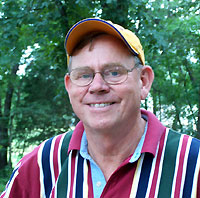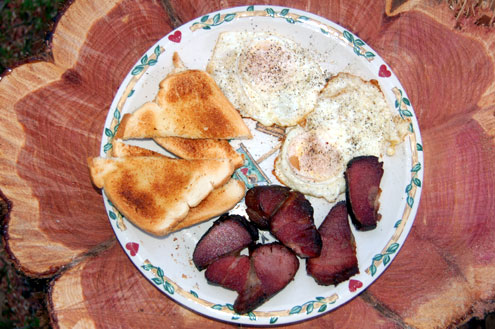
I am often asked questions such as "are wild hogs good to eat?" or "doesn’t venison have that ‘gamey’ taste?" I’ve found it impossible to answer these questions with a blanket statement.
I often reply with something like this: “If you were going to a hog farm to purchase your pork chops, would you choose the oldest boar? Likewise, you wouldn’t choose an older bull for your T-bone steaks! Younger game animals in good condition obviously make better table fare than older ones.
This is not to say that venison from older bucks, if prepared properly, is not good eating. I always use the center ham cuts, tenderloins and backstraps for steaks and grind the rest for sausage or add beef fat to it and make venison burger.

Because of its ‘dry’ nature, larger cuts of venison must always be cooked with moisture. I’ve slow cooked many venison hams with the end result a flavorful, tasty piece of meat. Slow cooking at low temperature is the key to preparing roasts from game animals.
I usually season the roast well with my favorite dry seasonings and a couple of bay leaves, and using a sharp knife, make incisions into the roast and insert pieces of bacon, slivers of garlic and onion or jalapeno pepper.
Then, covered with slices of fatty bacon and a little butter on top, I place the roast in a covered cast iron kettle and bake slowly for about 10 hours at 200 degrees. The meat falls off the bone and is well received at the dinner table when served with carrots, potatoes and onions (which I add to the roast a couple hours before serving).
Making BBQ from these larger cuts is another great way to please the crowd at hunting camp or home. I do a lot of my cooking on a Smokin Tex (www.smokintex.com) electric smoker and I’ve found it to be a very easy, carefree method of tenderizing larger, tougher cuts of meat.
I simply place the roast in a double layer of heavy duty foil, add BBQ sauce and allow to smoke uncovered a couple hours, using hickory, plum, peach or pecan wood. Then, wrapped in the foil, the roast is allowed to smoke at 200 degrees for up to 12 hours or so, or overnight. This method makes some of the best tasting, most tender BBQ imaginable. I often smoke cuts of wild hog, which have flavorful fat, with venison and blend the two for chopped BBQ.
Chicken-fried venison steak is better tasting than the best beef round steak, to my way of thinking. I use a tenderizing mallet and pound the steaks, adding dry seasonings during the process. Then, I cover the steaks with milk and refrigerate several hours before frying. Dipped in an egg batter and dusted with the flour, the steaks need only three or four minutes on each side in hot oil.
Drain the steaks, chop and sauté an onion in a little of the remaining oil and pour a big can of mushroom soup (with a little water) and you have smothered steak! Put a lid on the cast iron skillet and bake or cook on the stove top over low heat for an hour or so to tenderize; serve with hot rice and hot dinner rolls.
Preparing and cooking WATERFOWL requires a bit different technique but if all the duck dinners you have been served in the past tasted like ‘liver,’ chances are pretty good the cook didn’t have a clue on how to prepare and cook ducks and geese. Lanel Holland, my wife’s cousin, is married to the legendary waterfowl guide Jack Holland. Years ago, she instructed me in the proper way to prepare duck and goose breasts.
“It’s the blood in the meat of waterfowl that can give it the strong, liver flavor. Remove the breast halves and butterfly them," she instructed. "Then place in cold water and, using your hands squeeze the meat. This greatly aids in removing the blood in the meat.”
John Bryan, another friend that guides for ducks on the Brazos River, takes the process a step farther and uses a tenderizer mallet to tenderize the breast halves, then he places them in a pan of cold water. Waterfowl breasts, prepared thus, are excellent when wrapped in fatty bacon and grilled or, believe it or not chicken fried just like venison steaks. Served with hot biscuits and cream gravy, Bryan proved to me it’s tough to distinguish the flavor of duck breasts from chicken fried venison!
Quail and dove can be prepared and fried just like chicken. My friend and fellow outdoors writer Bob Hood came upon a method for preparing quail that is the best I’ve found. He places a couple rows of Ritz crackers in a plastic bag and crushes them into a fine meal. Next, in a Dutch Oven he melts a stick of butter, then coats the quail pieces (or chicken wings) in butter, then covers them with the Ritz meal. Cooked for about 1 hour, the quail are a golden brown. The Ritz meal batter is crunchy and adds a great deal of flavor to the game birds. Chicken wings can be substituted for quail if your supply is running low.
If you are going into the fall hunting seasons without left over game meat from last year, here’s a very easy and very tasty recipe for the opening evening meal at deer camp: Season a couple pounds of lean hamburger with your favorite dry seasonings and add chopped onion and raw rice, form into meat balls. In a 4 quart (or larger) Dutch Kettle, place layers of chunks of cabbage and seasoned meat balls. Sprinkle in a little rice as you go. Cover to within one inch of the top with Spicy V8 Juice. Simmer over low heat until the meat balls are well done. Serve with hot corn bread and you will become an instant ‘camp hero.’